| Pages:
1
2
3 |
woelen
Super Administrator
        
Posts: 8084
Registered: 20-8-2005
Location: Netherlands
Member Is Offline
Mood: interested
|
|
two times neodymium sulfate; different colors
I made neodymium sulfate two times from different source materials. Both materials are crystalline solids, but their colors are quite different.
Material 1 was made by dissolving powdered Nd2O3 (99.9% purity) in dilute warm H2SO4. The heating was needed in order to speedup the dissolving in the
acid. On very strong heating part of the Nd dropped out as a fine crystalline precipitate, the remaining liquid was allowed to evaporate over several
days. When most of the liquid was gone (which took many days), crystals had formed and these crystals were collected, rinsed two times with boiling
hot water (Nd-sulfate dissolves much less in hot water than cold water, hence the rinse with boiling hot water) and dried. The resulting crystals were
put in a small vial.
Material 2 was made from Nd-metal, which also had 99.9% purity. The metal was sold to me as an element sample, but unfortunately, when I looked at it,
a few years later, I just found a heap of grey powder and a few lumps of metal, nothing useful as sample anymore. I decided to buy a new sample,
ampouled under argon (which I still have to do), and use the powder and metal lumps for making Nd-sulfate. I added the grey powder and remains of
metal lumps to dilute H2SO4. Dissolving the powder went quickly, but the metal lumps only dissolved with great difficulty, they were covered by a
crust of Nd-sulfate. I decided to dissolve the metal lumps in 30% HCl, which works very well and this solution, together with the solution in H2SO4 I
put together and I added more H2SO4 to assure strong excess amount of sulfate ions. I filtered the material using good quality filter paper and the
result was a clear solution, more than 100 ml of solution. The solution has a pink/lavender color.
I allowed more than 90% of the solution to evaporate (this took many days) and this resulted in quite a large amount of pink/purple crystalline solid.
I rinsed this solid two times with boiling hot water and allowed it to dry. This I put in a second vial, the larger one.
Some tests:
- Add a solution of ammonium thiocyanate to the remaining liquid of both experiments. Both remaining liquids turn deep red. This is an indication that
both the Nd2O3 and the Nd-metal contained some iron (oxide).
- Dissolve some of the crystals in cold water and add thiocyanate. Not even a faint red coloration can be observed, so the iron has not contaminated
the crystalline solid. This is true for both samples of crystals.
- I tested the sample of the last experiment for chloride by dissolving some of the crystals in cold distilled water and adding some AgNO3. No
opalescence could be observed. As a counter test, I added a few drops of tap water and immediately some opalescence can be observed. Adding a drop of
dilute HCl results in formation of a thick white precipitate.
So, the samples are free of iron and free of chloride.
Here follow pictures of the samples (small vial the material made from Nd2O3 and the large vial contains the material made from Nd-metal and Nd2O3).
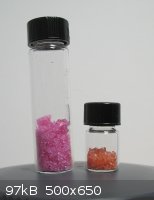 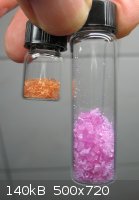
The left picture shows the materials under daylight and the right one under TL-light. There is a strong difference of color. Both samples, however,
give pale lavender solutions when dissolved in water.
What can be the reason of the strong difference in color? Are these different compounds?
|
|
|
bfesser
Resident Wikipedian
    
Posts: 2114
Registered: 29-1-2008
Member Is Offline
Mood: No Mood
|
|
I notice that the sample in the larger vial seems to stick to the glass. Is it as dry as the other sample? Perhaps different levels of hydration?
We're all familiar with the effect of hydration on the color of copper(II) sulfate. I see no reason why this couldn't be the case with neodymium(III)
sulfate. Perhaps gently heat a small crystal of each in a test tube and see how the colors change.
<img src="http://boomeria.org/chemtextbook/fig16-16.jpg" />
[Edited on 6/30/13 by bfesser]
|
|
|
woelen
Super Administrator
        
Posts: 8084
Registered: 20-8-2005
Location: Netherlands
Member Is Offline
Mood: interested
|
|
Both samples are perfectly dry. Maybe the sticking to the glass is due to some electrostatic effects. Of course, there can be different levels of
hydration, but why would you expect that to be so? I crystallized both from quite dilute solutions with excess amounts of acid in them.
|
|
|
Poppy
Hazard to Others
  
Posts: 294
Registered: 3-11-2011
Member Is Offline
Mood: † chemical zombie
|
|
I made my dimmy sulfates by dissolving then directly in conc. sulfuric acid and got beatiful iridescent powder.
This crystals are having a bad habit if so then!
|
|
|
bfesser
Resident Wikipedian
    
Posts: 2114
Registered: 29-1-2008
Member Is Offline
Mood: No Mood
|
|
<a
href="http://en.wikipedia.org/wiki/Word_salad" target="_blank"><em>"Has anyone really been far even as decided to use even go want to do look
more like?"</a></em> <img src="../scipics/_wiki.png" />
[Edited on 7/9/13 by bfesser]
|
|
|
Wizzard
Hazard to Others
  
Posts: 337
Registered: 22-3-2010
Member Is Offline
Mood: No Mood
|
|
I think the color is a product of thickness - Thin cross-sections make the samples rather red, and a Amethyst like purple... Thicker crystals are more
rosy-purple to lavender.
But your crystals look downright orange!!!! Perhaps it's some other Lanthanide?
I'm going to second that it may be different levels of hydration - Like copper sulfate
Lesser hydration (unknown, exactly... I have a thread somewhere about this)
http://www.theodoregray.com/periodictable/Samples/CuSO4.c/s1...
Normal hydration:
http://www.theodoregray.com/periodictable/Samples/CuSO4.a/s1...
|
|
|
Poppy
Hazard to Others
  
Posts: 294
Registered: 3-11-2011
Member Is Offline
Mood: † chemical zombie
|
|
Quote: Originally posted by bfesser  | | <a
href="http://en.wikipedia.org/wiki/Word_salad" target="_blank"><em>"Has anyone really been far even as decided to use even go want to do look
more like?"</a></em> <img src="../scipics/_wiki.png" /> |
lol, I don't know the purpose of that, but I'll try to clarify it some more:
from Crystals and Crystal Growing, by Alan Holden and Phylis Morrison
pag. 310 ref, picked at line 17, referred pag 123 Crystallographers call the characteristic shape of a crystal its "habit". They might say, "The
habit of alum is depicted j]in that figure", or they might speak of alum as "having an octahedral habit."
Moreover, for proof there isn't any kind of single path idea of determinism in chemistry,
Pag. 270 "...Notice that both of the substances, sugar and rochelle salt, which have this effect on light are derived from living thigs (?)" ...
"Unless some "life process" takes part, either in making the starting material for the chemical operations or as one of the process deliberately used
in manufacture, the product will be as inert as water or glass between two sheets of Polaroid" ... "You may protest that your crystals of sodium
chlorate have this effect on light, whereas their solutions does not, and no life process intervenes between the solution and the crystals growing
from it" ... "In other words, the "life process" which intervenes is you - the choice you make among your collection of seeds"
Then, finally, on retaliation:
pag. 273 "Almost always, when two kinds of molecules are mixed together, they form crystals in which the two kinds are still mixed together, and
the crystal has a plane or a center of symmetry. This mixture is like that of potassium sulfate and aluminium sulfate in alum; equal numbers of each
kind of molecules cooperate to form the orderly structure. In rare cases (perhaps not that rare as in the case of Nd compounds)
the two kinds of moelcules will crystallize out separately. Then a Crystal made from either kind of molecule alone will lack a plane of
symmetry."
Which is more than enough to start suspecting the apparent unreasonable color differences of both samples.

Perhaps the method of assay or contaminants may trigger one or another of the crystal habits, as it may have many, and so many are the sorts of shapes
relating to its symmetry, which implies color changes sometimes. sorry if thats not the case.
Hope I'm not convincedly playing jibber-jabber around, thank you.
[Edited on 6-30-2013 by Poppy]
<!-- bfesser_edit_tag -->[<a href="u2u.php?action=send&username=bfesser">bfesser</a>: fixed
broken image(s)]
[Edited on 7/9/13 by bfesser]
|
|
|
blogfast25
International Hazard
    
Posts: 10562
Registered: 3-2-2008
Location: Neverland
Member Is Offline
Mood: No Mood
|
|
woelen:
So much for '99.9 %' of course. The ferric thiocyanate test is sensitive but is it that sensitive? That would be worth testing or lit.
researching. In any case, the crystal samples are free of Fe.
I think I may have obtained both colours at once in one of my Nd experiments. I obtained fairly large crystals of Nd sulphate very much the same
colour as the 'small vial' and a much lighter, pinkish form of smaller crystals. The 'small vial' colour is what dominates the 'trouble with
neodymium' thread, in terms of Nd sulphate colour.
I would do this. Redissolve some of both substances in iced water, in identical conditions of mass, volume of solvent and temperature.
Test one. Heat some of both solutions and see what happens.
Test two. Add some conc. H2SO4 to some of both solutions and see what happens.
Test three. Allow some of both solutions to evaporate at RT and see what kind of crystals you get.
I believe the REs can be titrated with Na2EDTA. That would open the way to determine how much water each substance contains and thus which hydrate it
is. Or: gravimetrically by precipitating as oxalate. Higher hydrates tend to form at lower temperature and vice versa, as a rule of thumb.
[Edited on 30-6-2013 by blogfast25]
|
|
|
Poppy
Hazard to Others
  
Posts: 294
Registered: 3-11-2011
Member Is Offline
Mood: † chemical zombie
|
|
Or just for god sake take LARGER PICTURES OF ALL THE CRYSTALLSS!! and let us analyse their shapes...
Surely we can't decide which building blocks they belong to but we can see if they differ from one another quite easily.
Also, on addition to Blogfast25's suggested tests, repeat the one in which you dissolved them first with HCl.
I just redissolved the pink sample of Nd2(SO4)3 I had. I don't know if that was hydrate or not. I think I messed up a bit by not acidifying properly
the water before dissolving it, but then added like 5mL H2SO4 to a solution comprising 400mL filter water containing 21g of the Nd2(SO4)3, which
didn't dissolve completly until now. The solution is turbid. Anyway, lets see what crap I get after this refresh.
[Edited on 6-30-2013 by Poppy]
|
|
|
kmno4
International Hazard
    
Posts: 1517
Registered: 1-6-2005
Location: Silly, stupid country
Member Is Offline
Mood: No Mood
|
|
Quote: Originally posted by woelen  |
- Dissolve some of the crystals in cold water and add thiocyanate. Not even a faint red coloration can be observed, so the iron has not contaminated
the crystalline solid. This is true for both samples of crystals. |
SCN test for Fe(III) is pH sensitive when concentration of Fe is small. I would repeat it, but first add some (pure) HCl to the Nd solution. Next, you
can add some insoluble in water alcohol (butanol etc) and extract water phase by shaking (in test tube).
Colourless organic phase means "Fe-free" solution.
[Edited on 30-6-2013 by kmno4]
Слава Україні !
Героям слава !
|
|
|
bfesser
Resident Wikipedian
    
Posts: 2114
Registered: 29-1-2008
Member Is Offline
Mood: No Mood
|
|
<strong>woelen</strong>, how do the colors compare outside of those glass vials. I don't expect to see much difference, but perhaps the
glass of the different vials has slightly different absorbance/transmission. I'd still like to see what happens when a crystal of each is gently
heated.
|
|
|
blogfast25
International Hazard
    
Posts: 10562
Registered: 3-2-2008
Location: Neverland
Member Is Offline
Mood: No Mood
|
|
Quote: Originally posted by kmno4  | SCN test for Fe(III) is pH sensitive when concentration of Fe is small. I would repeat it, but first add some (pure) HCl to the Nd solution.
[Edited on 30-6-2013 by kmno4] |
I used this test professionally and quantitatively some 30 years ago and can't remember the actual detection limit. It would be worth making a 100 ppm
Fe3+ solution, and progressively dilute it by factors of 2, up to 'no signal', just to see...
Quote: Originally posted by bfesser  | | <strong>woelen</strong>, how do the colors compare outside of those glass vials. I don't expect to see much difference, but perhaps the
glass of the different vials has slightly different absorbance/transmission. I'd still like to see what happens when a crystal of each is gently
heated. |
I appreciate the genuine concern about perception of these colours but the difference is FAR too great to be attributed to a trick of the light or the
glass of the vials. This difference is genuine.
Different forms of Nd sulphate (maybe different allotropes [metaphorical use] even?) have been discussed here many times before.
[Edited on 30-6-2013 by blogfast25]
|
|
|
bfesser
Resident Wikipedian
    
Posts: 2114
Registered: 29-1-2008
Member Is Offline
Mood: No Mood
|
|
Do you have any cation exchange resin available for column chromatography? I don't see people from ScienceMadness doing much <a
href="https://en.wikipedia.org/wiki/Ion_chromatography" target="_blank">ion chromatography</a> <img src="../scipics/_wiki.png" />, and
it's a little sad. It's such an easy and effective means of separation for so many inorganic (and some organic) components. And the resin is usually
able to be regenerated and reused. I see many members pursuing HPLC, GC, and even centrifugal radial TLC, yet I don't recall seeing a single member
performing ion-exchange chromatography. With how easy and cheap it is, it's a wonder nobody here has continually advocated its use. It also seems to
me, that it would lend itself well to the style of homebrew 'technochemistry' that people here like to tinker with. You can start with nothing more
than a glass tube, resin beads, and a couple dozen test tubes. But members could build their own micro-controller based automated control and
detection systems and get as fancy as they like.
[/end off-topic rant]
Sorry.
[edit]
Sadly, a <a
href="search.php?token=&srchtxt=exchange+chromatography&srchfield=body&srchuname=&f%5B%5D=all&srchfrom=0&filter_distinct=yes&a
mp;searchsubmit=Search">search for "exchange chromatography"</a> yields less than one page full of results—many quite old, most
unrelated.
[second edit] Quote: Originally posted by blogfast25  | | Different forms of Nd sulphate (maybe different allotropes [metaphorical use] even?) have been discussed here many times before.
|
I think they're called crystal <a href="http://en.wikipedia.org/wiki/Crystal#Polymorphism_and_allotropy"
target="_blank">polymorphs</a> <img src="../scipics/_wiki.png" />, but I'm not positive. I'm just beginning to study crystallography
(under mineralogy as I pursue geology). Or perhaps you're refering to something like <a href="http://en.wikipedia.org/wiki/Crystal_habit"
target="_blank">crystal habit</a> <img src="../scipics/_wiki.png" />?
[Edited on 7/9/13 by bfesser]
|
|
|
watson.fawkes
International Hazard
    
Posts: 2793
Registered: 16-8-2008
Member Is Offline
Mood: No Mood
|
|
Calcination would be another way. You can't always take a hydrated salt to an anhydrous salt, but it's typical to be able to take a
more-highly hydrated salt to one with lower hydration.
You'd need a balance with good repeatability for it. Even without being able to measure any mass difference quantitatively, you can get a qualitative
result with a simple balance beam. First balance the crucible and charge with a nonce weight, such as a dish with sand. Second perform the
calcination. Third put the calcined dish back and see if it still balances.
|
|
|
adamsium
Hazard to Others
  
Posts: 180
Registered: 9-4-2012
Location: \ƚooɿ\
Member Is Offline
Mood: uprooting
|
|
Perhaps you're seeing some NdCln(3-n)+ complexes, Woelen.
These papers seem to indicate that chloro complexes of lanthanides are increasingly stable at higher temperatures and one (the second one) discusses
different results based on the use of neodymium chloride vs neodymium oxide. I've not had time to read them properly and I'm (obviously) far from
being an expert on this, anyway, but they would certainly be worth checking out:
Spectrophotometric study of Nd, Sm, and Ho complexation in chloride solutions at 100-250°C, S. A. Stepanchikova and G. R. Kolonin; Russian Journal of
Coordination Chemistry, Vol. 31, No. 3, 2005, pp. 193–202. Translated from Koordinatsionnaya Khimiya, Vol. 31, No. 3, 2005, pp. 207–217
The aqueous geochemistry of the rare earth elements and yttrium: VI. Stability of neodymium chloride complexes from 25 to 300°C, C. H. GAMMONS, S. A.
WOOD, and A. E. WILLIAMS-JONES; Geochimicaet CosmochimicaActa,Vol.60, No. 23, pp. 4615-4630, 1996
What colour were the solutions? You will also notice that the colour of NdCl3 (far right) is very much like your product where HCl was
used, while the sulfate (far left) is more like the one where HCl was not used. Interestingly, according to the neodymium page on wikipedia, some
compounds of neodymium have varying colour under different lighting conditions - see https://en.wikipedia.org/wiki/Neodymium#Compounds and the images of crystalline Nd2(SO4)3, confusingly, look like
your product where you used HCl. Perhaps a small amount of a chloro complex was stable enough in solution that the silver nitrate test didn't detect
it. So, I really don't know what's going on, but I'm quite curious to find out.
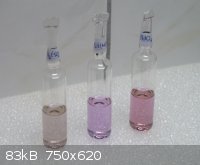
Image reference: https://en.wikipedia.org/wiki/File:Neodymium_tl1.jpg
I'd love to see:
if the appearance changes under different lighting conditions
the effect of adding a large excess of sulfuric acid
|
|
|
bfesser
Resident Wikipedian
    
Posts: 2114
Registered: 29-1-2008
Member Is Offline
Mood: No Mood
|
|
I've used both Amberlite® and Dowex® ion exchange resins in the past. Both are easily obtainable, even for the home chemist on a
limited budget. With the ingenuity of the members of this board, I wouldn't be surprised if someone managed to make their own, as well.
Quote: Originally posted by adamsium  | Spectrophotometric study of Nd, Sm, and Ho complexation in chloride solutions at 100-250°C, S. A. Stepanchikova and G. R. Kolonin; Russian Journal of
Coordination Chemistry, Vol. 31, No. 3, 2005, pp. 193–202. Translated from Koordinatsionnaya Khimiya, Vol. 31, No. 3, 2005, pp. 207–217
The aqueous geochemistry of the rare earth elements and yttrium: VI. Stability of neodymium chloride complexes from 25 to 300°C, C. H. GAMMONS, S. A.
WOOD, and A. E. WILLIAMS-JONES; Geochimicaet CosmochimicaActa,Vol.60, No. 23, pp. 4615-4630, 1996 |
I've <a href="viewthread.php?tid=19098&page=19#pid290268">requested</a> these articles.
[Edited on 7/1/13 by bfesser]
|
|
|
woelen
Super Administrator
        
Posts: 8084
Registered: 20-8-2005
Location: Netherlands
Member Is Offline
Mood: interested
|
|
Just to be sure that the effect of the presence of iron can be ruled out definitely, I assessed the sensitivity of my test with thiocyanate.
I dissolved 55 mg of FeNH4(SO4)2.12H2O in 1000 ml of water. This 55 ppm by weight, the iron ppm of course is much lower.
With 55 mg per liter, a bright red/rose color is obtained with concentrated solution of NH4SCN.
When diluted 10 times, the color cannot be observed anymore, but amazingly, when a few drops of reagent grade HCl (30%) are added, then the color
becomes pale pink again and the iron/thiocyanate complex is clearly visible again. I of course tested the HCl also without the iron and then it does
not give a positive with the thiocyanate.
The liquid can be diluted two to three times before the iron is not visible to me anymore. So, I can go down to let's say 2 mg per liter of dissolved
FeNH4(SO4)2.12H2O.
Next, I did the test with thiocyanate again, but now with added drop of 30% HCl. No positive reaction occurred.
I also did another very sensitive test on iron. I prepared a mix of K3Fe(CN)6 and K4Fe(CN)6 and added this solution to another sample of solution of
my Nd-sulfate samples. This only results in formation of a pale yellow precipitate (Nd-ferrocyanide), not the faintest indication of a blue color.
So, I a quite sure that no serious amounts of iron are present in the material, at least not so much that it clearly affects the color of the
crystals.
@adamsium: The picture you show is from my website  I donated it to Wikipedia. I
made it myself some years ago. I still have these ampoules, they are very nice demo objects and sometimes I show them to friends and show the
differences under different types of light. I donated it to Wikipedia. I
made it myself some years ago. I still have these ampoules, they are very nice demo objects and sometimes I show them to friends and show the
differences under different types of light.
|
|
|
Poppy
Hazard to Others
  
Posts: 294
Registered: 3-11-2011
Member Is Offline
Mood: † chemical zombie
|
|
crazy complexing sulphate
Quote: Originally posted by adamsium  |
I'd love to see:
if the appearance changes under different lighting conditions
the effect of adding a large excess of sulfuric acid |
This sample I have was prepared by rapid hot addition of Nd2O3 to conc. sulfuric acid. Note the picture with a precipitate at the bottom is white,
while the solution is pink. Comparing to the undissolved salt, which was pink in the same conditions, this ppt. must be Nd oxide or hydroxides. Their
origin is not certain (as from what caused them to precipitate, if they were a component from the first crystalization or if they were formed by
dissolution of the salt in neutral conditions which ultimately caused hydrolysis to occur. As the salt was neutralized with aq. NH4OH probably its a
residue of bad operating of the ingredients, but that can be ruled out once I recrystalize this from the water - too bad its filtered water  !!! - and dissolve again). Anyway, the hydroxides seems stable as I lately added
about 5mL conc. sulfuric acid to this solution and that didn't dissolve the white ppt. seen. !!! - and dissolve again). Anyway, the hydroxides seems stable as I lately added
about 5mL conc. sulfuric acid to this solution and that didn't dissolve the white ppt. seen.
Redissolving to rule out color differences is useless: note the solution after shaking - I know its the ppt which is making it turbid all the way but
salts generally don't fully ionize once dissolved (not fully solvated) so ridiculus small seed might stil be wandering around and this experiment can
be considered "dead" as it won't give other crystal forms through with simple recrystalizations. Philosophically, maybe not even renautralization of
an oxide obtained from that solution may nerf this crystal eed problem: one ought to go into the metallic state and watch out the
paths he chooses to dissolve it in first place. 
PS.: my samples were INITIALLY dissolved Nd from magnets in HCl, neutralized to hydroxide, calcined and added to hot conc. H2SO4. As Alan Holden's
book says, this might influentiate, but not rule out completely, the formation of this specific habit (that is, neutralization gave rise to a habit on
the hydroxyde that survived all the way to salt).
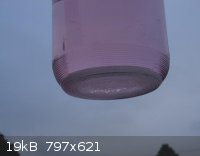 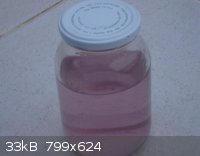 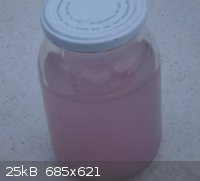
[Edited on 7-1-2013 by Poppy]
|
|
|
blogfast25
International Hazard
    
Posts: 10562
Registered: 3-2-2008
Location: Neverland
Member Is Offline
Mood: No Mood
|
|
Quote: Originally posted by woelen  | Just to be sure that the effect of the presence of iron can be ruled out definitely, I assessed the sensitivity of my test with thiocyanate.
I dissolved 55 mg of FeNH4(SO4)2.12H2O in 1000 ml of water. This 55 ppm by weight, the iron ppm of course is much lower.
With 55 mg per liter, a bright red/rose color is obtained with concentrated solution of NH4SCN.
When diluted 10 times, the color cannot be observed anymore, but amazingly, when a few drops of reagent grade HCl (30%) are added, then the color
becomes pale pink again and the iron/thiocyanate complex is clearly visible again. |
Excellent. What was the testing protocol? In plain English, how much ferric solution, how much SCN- solution and at what concentration [ooops: it does
say 'concentrated']?
Quote: Originally posted by watson.fawkes  | [Calcination would be another way. You can't always take a hydrated salt to an anhydrous salt, but it's typical to be able to take a more-highly
hydrated salt to one with lower hydration.
|
I fear hydrolysis, Watson. RE salts are quite prone to it. Especially as it is difficult to demonstrate that it occurred (or not). Ideally you’d
need a thermo-gravimetrical scan or possibly DSC to determine when the hydrate loses water and when that stops.
@bfesser: chromatography enabled with detection of various REs is outside the capability envelope/budget of 99.9 % here, sadly...
My own neodymium sulphate (it appears slightly darker to the naked eye - cr*pshoot camera):

... but I did also obtain a much more pink version once.
[Edited on 1-7-2013 by blogfast25]
[Edited on 1-7-2013 by blogfast25]
|
|
|
watson.fawkes
International Hazard
    
Posts: 2793
Registered: 16-8-2008
Member Is Offline
Mood: No Mood
|
|
Quote: Originally posted by watson.fawkes  | Calcination would be another way. You can't always take a hydrated salt to an anhydrous salt, but it's typical to be able to take a more-highly
hydrated salt to one with lower hydration.
|
Quote: Originally posted by blogfast25  | | I fear hydrolysis, Watson. RE salts are quite prone to it. Especially as it is difficult to demonstrate that it occurred (or not). Ideally you’d
need a thermo-gravimetrical scan or possibly DSC to determine when the hydrate loses water and when that stops. |
I'll certainly acknowledge that the quantitative versions are more difficult. The qualitative one, though, seems easy to check. Just
heat them up and see if they lose mass. If it does, it's either water of hydration (my initial thought) or perhaps driving off HCl if there's a
chloride complex about. Either way it's a null result or some non-null result, even if a non-null result wouldn't yield much further information.
One possible result is that one color loses mass and the other doesn't. That would be new information.
Separately, I might mention that a student spectroscope would allow you to see how different the emission spectra actually are, even without being
able to take a calibrated spectrum. In addition, if the two samples have different crystal structures, they would likely also have different indices
of refraction. I don't know what your crystallographic test equipment is, but given your interests, you might think about some.
P.S. Re-hydration shouldn't be a problem if you weigh the samples quickly after they come out of the oven and if you use a lid.
Edit: P.S.
[Edited on 2013-7-1 by watson.fawkes]
|
|
|
blogfast25
International Hazard
    
Posts: 10562
Registered: 3-2-2008
Location: Neverland
Member Is Offline
Mood: No Mood
|
|
@Watson:
My money would be on crystal water. In the instance where I obtained the material picture above I also obtained a pink, much less crystalline looking
material. The latter had formed first, from higher temperature, the former, more reddish compound developed the next day from cold (perhaps
saturated) solution. Higher hydrates tend to form in colder areas of the phase diagram.
I might subject a few samples of the reddish salt (believed to be the octahydrate) to a few temperatures and see what happens. Unfortunately I don't
have any of the pinkish version left for comparison.
[Edited on 1-7-2013 by blogfast25]
|
|
|
Random
International Hazard
    
Posts: 1120
Registered: 7-5-2010
Location: In ur closet
Member Is Offline
Mood: Energetic
|
|
NdCl3 is a mauve colored hygroscopic solid whose color changes to purple upon absorption of atmospheric water. The resulting hydrate, like many other
neodymium salts, has the interesting property that it appears different colors under flourencent light- In the chloride's case, light yellow (see
picture).[1] The color difference is likely due to the charge transfer converting the Nd3+ ions into the Nd2+ state; the orange absorption band of
Nd3+ decreases and the green Nd2+ absorption increases producing the yellowish color.[2][3]
From wikipedia. Maybe you somehow made Nd3+ and Nd2+ in separate vials?
Maybe some double salt formed?
|
|
|
Poppy
Hazard to Others
  
Posts: 294
Registered: 3-11-2011
Member Is Offline
Mood: † chemical zombie
|
|
Okay, like gold, after each precipitation it changes color
see: http://philosophicalmercury.page.tl/Blue-Gold.htm
Statistics anyone? seemingly the first crop always looks a little oranger...
|
|
|
bfesser
Resident Wikipedian
    
Posts: 2114
Registered: 29-1-2008
Member Is Offline
Mood: No Mood
|
|
Thanks to <strong>solo</strong>, <a href="viewthread.php?tid=19098&page=19#pid290291">here</a> are the papers
<strong>adamsium</strong> referred to.
<strong>Poppy</strong>, as of this post, your link is broken. Here's a <a
href="http://webcache.googleusercontent.com/search?q=cache:wdAEMhVPJYwJ:philosophicalmercury.page.tl/Blue-Gold.htm+&cd=1&hl=en&ct=clnk&
;gl=us" target="_blank">cached copy</a> <img src="../scipics/_ext.png" /> of the page on Google—which I can't be arsed to
read, because it's on a website entitled <em>Alchemy Illuminated</em>.
[Edited on 7/9/13 by bfesser]
|
|
|
adamsium
Hazard to Others
  
Posts: 180
Registered: 9-4-2012
Location: \ƚooɿ\
Member Is Offline
Mood: uprooting
|
|
Quote: Originally posted by woelen  | @adamsium: The picture you show is from my website  I donated it to Wikipedia. I
made it myself some years ago. I still have these ampoules, they are very nice demo objects and sometimes I show them to friends and show the
differences under different types of light. I donated it to Wikipedia. I
made it myself some years ago. I still have these ampoules, they are very nice demo objects and sometimes I show them to friends and show the
differences under different types of light. |
Haha, well that's funny. I didn't even see that it was yours and apparently haven't looked at that page on your site. I normally recognise your
pictures on wikipedia; many of the ones with compounds in small bottles on a plain background.
Anyway, another interesting thing to try would be to try saturating a solution with chloride, especially with strong heating.
Is there any reasonable possibility that your neodymium was mislabelled? From what I have seen, I know you're much more organised than that, but
perhaps your source of the neodymium was not. It seems that most neodymium compounds will be pink, but other lanthanides give other colours, including
yellowy orange-ish.
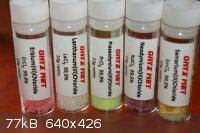
From http://www.aukcjoner.pl/gallery/013246618-.html#I2
|
|
|
| Pages:
1
2
3 |